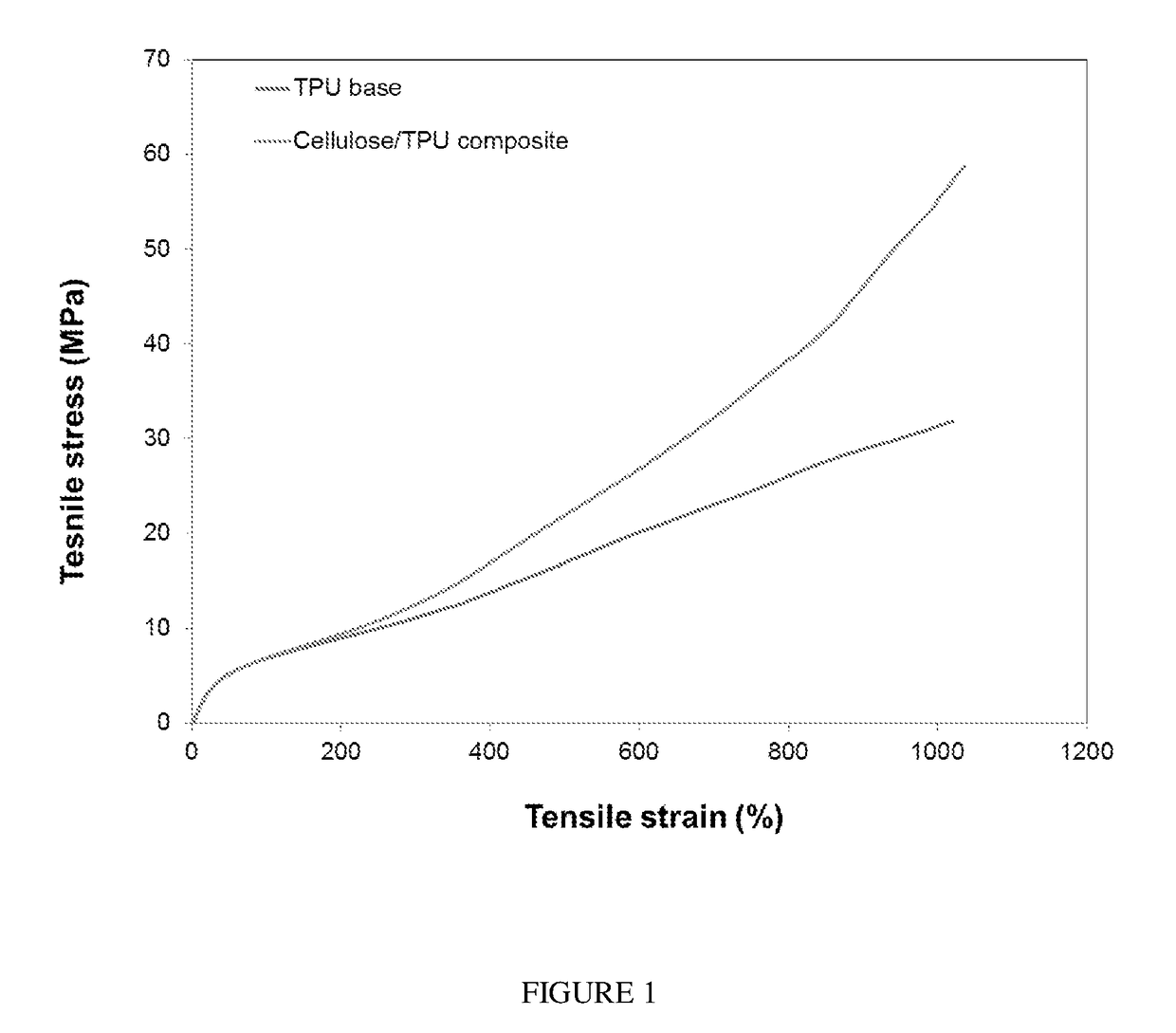Nanocomposite elastomers
a technology of elastomers and nano-composites, which is applied in the direction of hemicellulose adhesives, catheters, other domestic articles, etc., can solve the problems of poor compatibility of unmodified cellulose fibres, poor dispersion of rubber, and use of unmodified cellulose as a reinforcing agent in rubber composites, etc., to achieve high strength, reduce the number of pin holes, and build up the thickness of elastomer
- Summary
- Abstract
- Description
- Claims
- Application Information
AI Technical Summary
Benefits of technology
Problems solved by technology
Method used
Image
Examples
example 1
[0076]Nanocomposites were prepared via reactive extrusion of a stable, very dry (<300 ppm water) PTMEG 1000 polyol-CNC suspension with dimethyl diphenyl diisocyanate (MDI) and 1,4-butanediol (BDO). Table 1 summarizes the amount of each components used for making blank TPU and its nanocomposites with CNC (CNC was obtained from acid hydrolysis of Spinifex pulp using 40% (v / v) sulphuric acid for 3 hours at 45° C.).
TABLE 1CNCHardPolyolcontentIsocyanatesegmentflow rateSamplePolyol type(%)indexratioStoichiometry(g / h)X1PTMEG1000—10.4411797.6X2PTMEG1000 + CNC0.46510.4411812.5X3PTMEG1000 + CNC0.46510.441.011812.5X4PTMEG1000 + CNC0.46510.441.021812.5X5PTMEG1000 + CNC0.46510.441.031812.5BDODieMDI flowflow rateTorquepressureSamplerate (g / h)(g / min)(%)(bar)X11157.6254.826-2715X21157.6254.82616X31169.1254.830-3121-22X41180.7254.839-4032-33X51192.3254.84337-38Young's ModulusTensile strainTensile stressWork at fractureSample(MPa)(go)(MPa)(MJ m-3)X114.5 ± 1.21124 ± 3141 ± 3237 ± 10X216.6 ± 0.31115 ± ...
example 2
[0080]In example 2, a composite material was produced from nanofibrillated cellulose and natural rubber latex (non-vulcanised). Nanocellulose was present in an amount of 1% wt of the composite.
[0081]The nanocellulose suspension (0.3-1%) was obtained via high-pressure homogenisation of spinifex pulp (T. Pungens) fibre. The nanocellulose used had a hemicellulose content of 42% w / w and a fibre diameter of 3.5 nm. Prior to mixing, the pre-vulcanized rubber latex (Gedeo concentrated mould making formula, Pebeo, France) was diluted to 20-50 mg / mL (on dry weight basis) depending on final composition (0.25, 0.5 and 1 wt. %). Both the suspensions were mixed together by magnetic stirring for 2-3 h, homogenised (using a hand held rotor-stator homogeniser) for 1-2 minutes and allowed to gently stir for another hour to degas. After degassing, the homogeneous mixture was cast onto Teflon petri-dishes, dried at 40° C. for 12 h-50 h (depending on nanocellulose content and volume) to obtain control ...
example 3
Nanocellulose Reinforced Synthetic Rubber (Polyisoprene)
[0083]A composite of synthetic rubber (Cariflex IR401 polyisoprene latex in water) and nanocellulose (NFC with 42 wt. % hemicellulose content and 3-4 nm fibre diameter) was fabricated where the NFC was present at a loading of 0.53 wt. % (dry NFC mass) and rubber made up 99.47 wt. % (dry rubber mass) of the total nanocellulose plus rubber dry mass. The NFC was well dispersed as a 3.5% w / v aqueous dispersion and this was added to the Cariflex IR401 latex dispersion which had a solids content of 66% wt. Addition was done at room temperature and the mixture was stirred gently for 1 hour after addition. Sulfur (0.6% wt. of total solids mass), ZnO (0.2% wt. of total solids mass) and zinc diethyl dithiocarbamate (ZDEC, 0.5% wt.) were then added slowly to the dispersion to avoid shocking the latex. After all additions were completed, stirring was continued for 1 hour. After that stirring was stopped and stirred just once a day for 30 m...
PUM
| Property | Measurement | Unit |
|---|---|---|
| Fraction | aaaaa | aaaaa |
| Fraction | aaaaa | aaaaa |
| Fraction | aaaaa | aaaaa |
Abstract
Description
Claims
Application Information
 Login to View More
Login to View More - R&D
- Intellectual Property
- Life Sciences
- Materials
- Tech Scout
- Unparalleled Data Quality
- Higher Quality Content
- 60% Fewer Hallucinations
Browse by: Latest US Patents, China's latest patents, Technical Efficacy Thesaurus, Application Domain, Technology Topic, Popular Technical Reports.
© 2025 PatSnap. All rights reserved.Legal|Privacy policy|Modern Slavery Act Transparency Statement|Sitemap|About US| Contact US: help@patsnap.com


